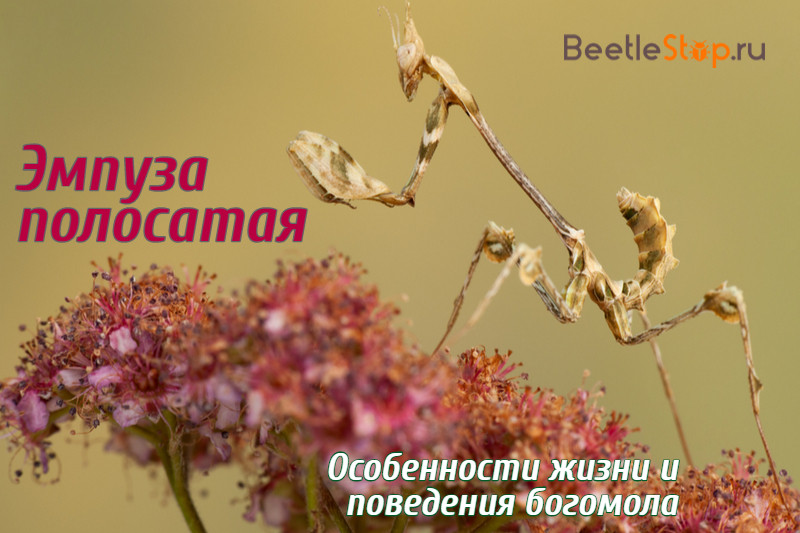Striped empusa - Crimean mantis needs protection
In nature, there are more than 2800 species of mantis. Predatory insects are distinguished by a thin elongated body, a triangular head and peculiar habits. While waiting for prey, they put the shins of the front legs into a special groove on the hips. On the part of their limbs resemble the pose of a prayer. Striped empusa is a typical representative of a mantis order. Insects live in the warm climate of the Mediterranean, Central Asia, Transcaucasia. The species is vulnerable and is listed in the Red Book of the Krasnodar Territory.

Morphological description of the species
Striped Empusa (Empusa fasciata) - a representative of the order of the mantis, the family of empusids (Empusidae). The small genus empusa (Empusa) includes only 15 species. Their characteristic feature is short spurs on the hips of the front and rear legs. Empusa is a striped large insect whose body size is 50-65 mm. The head of a triangular shape narrows in the mouth. It is crowned with a mitro-shaped helmet. The apical part of the head process is expanded; females have middle teeth on the sides of the process.
Complex eyes are oval. They are located on the sides of the head at a considerable distance from each other. The mouth apparatus is gnawing, directed downward. The males have long feathery antennae, the females are filiform. The body is very elongated in the thoracic region. The front grasping limbs are equipped with rows of sharp spikes to hold the victim. The main body color is greenish-yellow or gray. On long thin legs, a pattern in the form of stripes. Sexual differences are manifested in the size of adults - females are larger than males.
Information. Camouflage coloring allows the mantis to blend perfectly with the surrounding plants. It is noticeable only during movement.
On the walking limbs and abdomen, growths in the form of plates were formed, which are part of the disguise of the insect. Flattened abdomen, consists of 10 segments. At the end are paired appendages - jointed churches. They are an organ of smell. The spikes on the front hips are arranged in groups, 3-4 short spikes are separated by one long spike. At the end of the lower leg there is a sharp hook. Middle and hind limbs are used for movement. The front and rear wings are well developed. A narrow and dense front pair acts as an elytra.
Interesting fact. Praying mantises have excellent eyesight, thanks to a moving head, it is the only one of the insects that can look behind itself.
Habitat
The empusa striped lives in the north of Africa, India, Iran, Israel, Turkey, Cyprus. The species is common in the south of Europe - Greece, Romania, Slovenia, the Balkans. It is found in Russia in the Crimea. On the Taman Peninsula, near Novorossiysk, Northern Ozereyevka, Gelendzhik, isolated individuals of the species Empusa fasciata were found. In Slovenia, insects live on limestone slopes with xerophilic shrubs.
Behavior features
Mantis are active in the daytime. They are tied to one site. The usual conditions leave only with a lack of food supply. Empuses sit on tall herbs, holding on to four limbs and folding their front legs in a characteristic prayer position.Their favorite places are the bright edges of pine forests, mixed meadows, hillsides overgrown with shrubs.
Food
Praying Mantis is an ambush predator. He freezes in stillness, waiting for the approach of flies, grasshoppers, butterflies and other flying insects. Having noticed prey, the mantis carefully approaches, at a distance of throwing limbs it stops and swiftly attacks. In the process of feeding, the mantis holds the prey, sandwiched between the thigh and lower leg. Lunch is delayed for 30-40 minutes.
Spotted empusa specializes in catching flies and bees. These insects are numerous and nutritious. With limited feed, they help mantis grow and develop. Females, who especially need protein, are waiting for flying insects on flowers. They catch bees keen on collecting nectar or grab in the air.
Repel an attack
The insect tries to frighten a possible enemy with an awesome pose, rocking and spreading its wings. They prefer to fly away from a strong enemy. Natural enemies empus: snakes, birds, reptiles.
Diapause
Winter colds and summer heat spotted empusu helps to survive the ability to immerse in diapause. All life processes are slowed to a minimum, the insect looks dead. When adverse conditions are replaced by comfortable, mantises come to life.
Flight
During the flight, the front and rear wings of the insect move simultaneously. Speed is up to 30 strokes per second. The striped empus flies during the day, only males of the species make night flights in search of the female. They are guided by the smell of pheromones, captured by the cirrus tendrils.
Breeding
The breeding season of the mantis begins in June. Male and female mate repeatedly. Shortly after fertilization, the female males die. The female lays eggs in groups of 100-300 pieces. Like cockroaches, it protects the masonry with a capsule. After laying, the empusa covers the eggs with a special brown liquid, when hardening, forming a swelling. Clutches are attached to plants. By July, females die.
The progeny of insects with incomplete transformation are called nymphs (larvae). They leave eggs in July. Outwardly, the offspring is similar to adult praying mantises, only it has no wings. Larvae of the first ages feed on aphids and leaf flies. After 2-3 molts, they begin to catch flies, butterflies and other dipterans. Nymphs of older ages overwinter. Development ends in the spring of next year.
Interesting fact. Empusa nymphs mimic the flowers of Fumaria densiflora (the Russian name is smoky).
Security status
Plowing steppes and recreational activities lead to a reduction in the number of Empusa fasciata. Mantis is included in the Red Book of the Krasnodar Territory and the Red Book of Ukraine.

